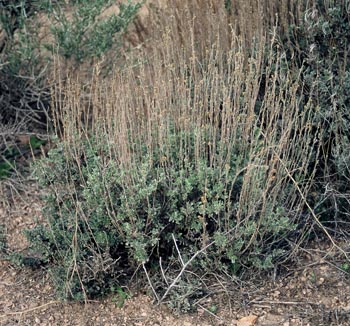Black Sagebrush

Common Name(s):
Black Sagebrush
Black Sage
Scientific Name:
Artemisia nova A. Nels.
Scientific Name Synonyms:
Artemisia arbuscula Nutt. ssp. nova (A. Nelson) G.H. Ward
Artemisia tridentata Nutt. ssp. nova (A. Nelson) H.M. Hall & Clem.
Seriphidium novum (A. Nelson) W.A. Web
Symbol:
ARNO4
Description:
Life Span: Perennial
Origin: Native
Season: Evergreen
Growth Characteristics: A small, spreading, aromatic shrub, with a rounded crown and a dwarf growth habit, growing only 10 to 18 inches tall. It flowers August to September and reproduces from seeds.
Flowers/Inflorescence: The flowers are small, and oblong, occurring in smaller numbers than big sagebrush. The flowering stalks ascend above the herbage, and are brownish or tan in color.
Fruits/Seeds: Seeds are brownish, flattened, and without hairs.
Leaves: Alternate. They are 3 lobed, with the leaf constricting immediately below the lobes, somewhat like a chickens foot. The leaves are dark to pale green, and often hairy. Glands can be seen on the leaves.
Stems: Twigs are round, short, rigid, light to dark reddish-brown, becoming black with age. The trunk is dark, reddish-brown to black.
Ecological Adaptions:
Black sagebrush is found on gentle, rocky slopes and windswept ridges in dry, shallow soils, in the foothills and desert mountain ranges of Utah, at elevations of 4,000 to 8,000 feet. It is closely associated with the salt-desert shrub habitats.
Soils: Black sagebrush can grow in soils ranging from clayey to gravelly. It prefers soils that are dry, shallow, gravelly, and well drained. It is usually associated with soils underlain by caliche or impervious pans.
Associated Species: Big sagebrush, shadscale, bluebunch wheatgrass, Indian ricegrass, and bottlebrush squirreltail.
Uses and Management:
Black sagebrush provides good forage for livestock, but is poorly consumed in the summer. It provides excellent winter browse for sheep and pronghorn. When black sagebrush is consumed by sheep prior to consuming Tetradymia sp., it can contribute to the development of bighead. Black sagebrush is important to sage grouse for nesting.
Moderate mid-winter or alternate years grazing systems are recommended for maintenance of black sagebrush.
Some American Indians drank a decoction of the boiled stems, leaves, and twigs for bronchitis. The leaves were crushed and the vapor inhaled to relieve nasal congestion.

